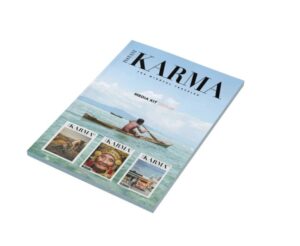Nusa Islands

The Klungkung Regency is one of those areas you pass to get to another place. If you are going to Karangasem or Lombok, you’ll pass Klungkung. It is a small regency, the smallest one in Bali, with only 315km2 of land, and 64.4% of it lies offshore in the three Nusa islands of Nusa Penida, Nusa Lembongan, and Nusa Ceningan.
Most people travel to the Nusa islands trio via Sanur, a 30-minute boat ride, but you can also take a fast boat or ferry from Padangbai port, along with your motorbike, if you want that convenience. The islands have become an increasingly popular tourist destination since the late 2000s as more and more people discovered its natural splendor, away from the maddening crowd of Bali’s major attractions.
The three Nusa islands are part of a cluster of islands (similar to Kepulauan Seribu or the Thousand Island Regency off the coast of Jakarta), but they stand out from the rest. They are less jam-packed with cafes and resorts than Gili Trawangan (a blessing) and perhaps not as aloof and remote as one might think.
Still, they have their own fascinating culture and tradition unique to the islands, like Nyepi Segara and the mystical dance Sang Hyang Jaran. Oh, and of course, there are the white sand beaches and the clear blue water. We are still in Bali, after all.
Goa Giri Putri
Unveiling the Mysteries of Bali’s Cave Temple
The holy temple (pura) in Bali is one of the world’s most exquisite places of worship, and
it can be found in unimaginable locations. Including in caves. The Goa Giri Putri in Nusa Penida is home to not one but five temples where the residents pray and hold ceremonies on sacred dates.
Considering the almost crawly way to get to the temples, it’s impressive how they built a temple in such a confined place, significantly since you must climb 110 steps and slip through an 80cm opening to enter the Goa Giri Putri.
The temple is dedicated to Siwa, the God of Destruction and Recreation, who, along with Wisnu and Brahma, makes up the holy trio of gods in Balinese Hinduism. Interestingly, the last name of the cave—”putri“, meaning female—refers to the inherent nature of God as being kind and nurturing.
The Balinese also pay pilgrimage to Goa Giri Putri to bring home holy water from inside the cave as it’s believed to have healing powers. Even though it’s a religious site, outsiders may visit the cave (30 minutes from Toyapakeh village), but it’s best to have a local guide to show you the steps if you plan to take part in a kind of cleansing, an open-for-tourist ceremony led by a priest. And always remember: wear respectful clothes.
Nusa Lembongan
Nusa Lembongan welcomes the most visitors of the three islands due to its more accessible terrain. Popular sites include the spectacular wave breaker Devil’s Tears and the picturesque white-sand Mushroom Bay Beach.
Another common sight in Nusa Lembongan is the bustling activities of seaweed farmers all along the coastline. Once abandoned in favor of a more lucrative career in the tourism and hospitality sector, seaweed farming is now back in business—in part due to the pandemic, when many families turned to this practice in a bid to support themselves and their communities, including the younger generation.
At dawn, the farmers head to the beach to tend to their red seaweed (of the kappaphycus alvarezii and Eucheuma spinosum variety), which only takes 30 days to harvest. “What’s great about seaweed farming is that anybody can do it, and the water in Lembongan is perfect for seaweed cultivation,” says Made Masak, a chef at Morin Resort who incorporates seaweed for her dessert and smoothie bowls. Interesting fact: Indonesia was the number one exporter of seaweed back in the 80s, used for consumption and the pharmaceutical and beauty industry. Once tourism set in, however, the production decreased, and now China is the leading exporter of seaweed.
But things can turn around in the future. Chef Made, for one, champions local food sources, and seaweed is an excellent part of it not only in Lembongan but also in the Nusa Penida and Nusa Ceningan.
Other foundations in the Nusa Islands are also trying to spotlight seaweed cultivation in Nusa Lembongan, such as the Coral Triangle Center, which supports the women farmers from Suana village (whose husbands left the profession to work in hotels) and Made Suarbawa from Good Farming Story who has been cultivating seaweed for 30 years.
Their mission is the same: expanding the role of the island’s inhabitants beyond mere sellers of the seaweed they farmed and as creatives that can process and market them for international consumers. The promising results include seaweed crackers, soaps, and dishwashing liquid.
To see the seaweed farmers in action, go to Mahagiri Beach or around the Lembongan-Ceningan iconic yellow bridge.
Nusa Ceningan
Last but not least is Nusa Ceningan, the smallest of the three islands between Penida and Lembongan. Ceningan is more of an extension of Lembongan and is connected by the photogenic jembatan cinta or love bridge.
Seaweed cultivation is practiced here in the Nusa Islands, too, as are the dances and Nyepi Segara. As mentioned, the island is small, clocking in at only three-square kilometers, so you can easily trek the whole island in just a couple of hours. Travelers come to Ceningan to snorkel, surf, and cliff jump. Blue Lagoon, the island’s most popular site, offers dreamy, turquoise water, but due to its strong current, there are better places to swim.
Though it might be seen as the lesser of the three, Nusa Ceningan’s natural charms will impress you nonetheless.
Other Highlights of the Nusa Islands
Silent Seas Celebration in the Nusa Islands
Nyepi Segara is a unique tradition found only in Nusa Lembongan and Ceningan. We are already familiar with the world-renowned Nyepi or Day of Silence all across Bali, in which all activities cease and the source of lights is turned off for a whole day as part of the steps to welcome their New Year in a contemplative fashion.
In Nyepi Segara (sometimes called Nyepi Laut), the ceasing of all activities only happens out in the ocean. So, no fishing, boat riding, surfing, swimming, and beach strolling—all prohibited as a sign of deference to the Sea God, Dewa Bharuna. Before the day, the village people will hold a ceremony at the beach to pray and present offerings that include sacrificial animals like chickens or ducks. On-land excursions, however, are still allowed.
Nyepi Laut occurs annually every October in the Nusa Islands during the 4th cycle of the full moon.
Dances with Horses
Traditional dances in Bali tell the story of the gods (usually a depiction from the epic Ramayana or Mahabharata). And in its authentic form, the experience can be quite haunting and mystical as dancers are possessed by spirits, making their bodies impenetrable by sharp or burning objects.
The Sang Hyang Jaran traditional dance has many versions in every region of Bali. The one in Nusa Lembongan conveys the story of Dewa Siwa in his quest to find the source of holy water. The priest Ida Pedanda Gede Punia created the dance, similar to the kuda lumping dance in East Java.
Dancers ride on a bamboo horse, and at one point, in a magnetic trance, he will dance on flaming hot charcoals made from coconut shells—unharmed. Unlike other traditional dances accompanied by gamelan, the Sang Hyang Jaran dance is serenaded instead, and the singers’ vocalization dictates the dancers’ movement.
These days, there are not a lot of residents of Lembongan who can perform the Sang Hyang Jaran dances, and at present, only two community groups—both based in Jungutbatu village—are known to practice it still.









